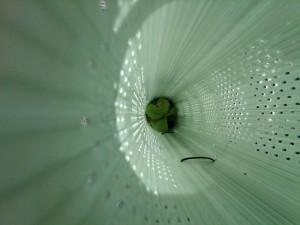
The winds are howling but this bur oak seedling is safe from stress inside its Tubex Combitube Treeshelter
I took this photo yesterday morning. The day was sunny (mostly – and for a change) but the winds winds were howling – 20+ mph gusting to 40. Do you think this bur oak seedling – safe within its tree tube – was worried about the wind?
Wind is extremely stressful for newly planted seedlings. It sweeps away the humid envelope of air that surrounds the leaves. For several weeks after planting, a seedling’s roots are not completely “knitted” into the soil and cannot efficiently draw new moisture. In high winds seedlings can quickly dry out.
The way that seedlings defend themselves against wind is to essentially shut down. They close their stomata (pores) to conserve moisture. This does reduce moisture loss, but it also stops growth.
Not in a tree tube. Wilson Tree Tubes completely shield your seedlings from the drying, stressful effects of the wind. While other bur oak seedlings were either losing moisture faster than their newly-planted roots could replenish it or stopped photosynthesis in order to conserve moisture, this bur oak was happy as a clam; a moist envelope of air surrounded its leaves and it was photosynthesizing at full bore.
That’s why trees grow faster in tree tubes: They are actively photosynthesizing on days when un-tubed trees are just hanging on for dear life.
Which leads to another reason trees grow faster in tree tubes: Leaf structure. When you compare the leaves of seedlings inside tree tubes and the leaves of un-tubed seedlings you see there is a stark contract. The leaves of un-tubed trees are small, darker, and thicker. The are stress leaves, designed to keep the tree alive under stressful conditions. They are not designed for optimal growth.
Now take a look at the leaves of tubed seedlings. They are big, bright green, lush. These are growth leaves; unhindered by moisture stress they are optimized for rapid, healthy growth. Lots of surface area for sunlight absorption and transpiration.
Many customers remark about the red tint of leaves in tree tubes, especially those near the growing tip (apical meristem). Why are they tinted red? Honestly, I have no idea. But I do know that when you see that red tint you know your trees are growing extremely fast.
